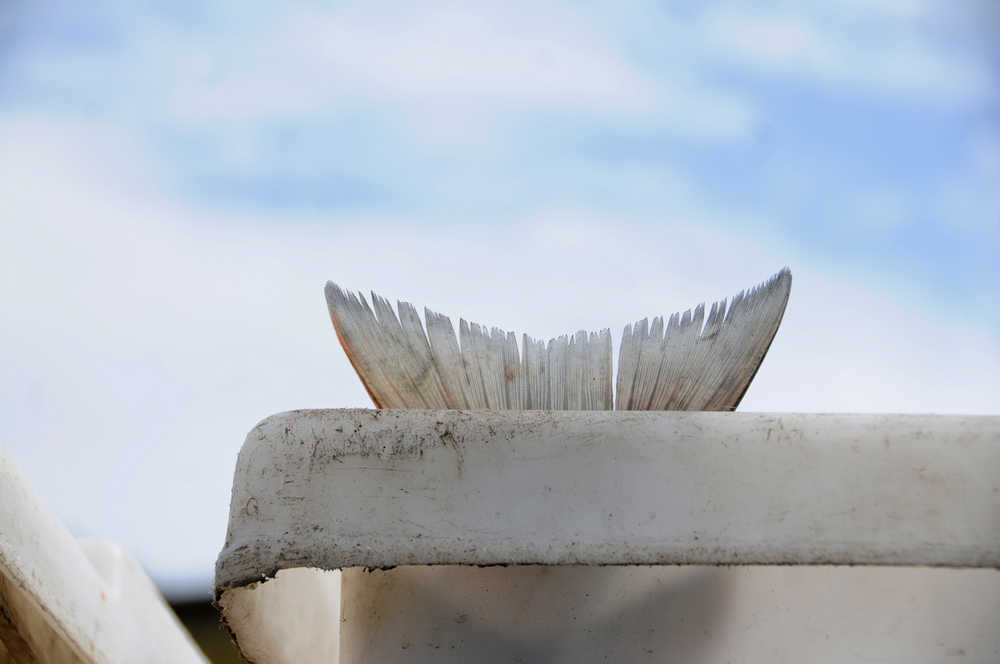Editor’s note: This article has been corrected to show that the Division of Commercial fisheries originally projected between 4.3 and 5.6 million sockeye to return to the Kenai River and between 6.4 million and 8.3 million returning to Upper Cook Inlet.
Commercial fishermen expected to see a large harvest this year, based on forecasts, but it doesn’t looks like those predictions will carry through.
As of Wednesday, more than 1 million sockeye salmon had passed the Alaska Department of Fish and Game’s sonar in the Kenai River. Fish and Game biologists a had originally projected between 4.3 million and 5.6 million sockeye would return to the Kenai River this season, with a total of between 6.4 million and 8.3 million sockeye returning to the entire Upper Cook Inlet system. An assessment the Division of Commercial Fisheries completed through July 26 upheld the original forecast.
However, it now looks like the run will come in lower than predicted — about 1 million less than projected will come to the Kenai River, and a total of between 1.8 million and 1.9 million fewer fish will return to Upper Cook Inlet, according to Pat Shields, the area management biologist for the Division of Commercial Fisheries in Soldotna.
“Since (July 26), the sockeye run has really slowed down,” Shields said. “It really has decreased in its daily entry into the inlet.”
It seems the Kasilof run will come in under the forecast as well. Fish and Game projected a smaller run than the 10-year average, about 860,000 fish, in the preseason forecast; now it looks like that run will come in closer to about 600,000 fish, Shields said. As of Wednesday, 215,356 sockeye had passed Fish and Game’s sonar in the Kasilof River, a little less than half of what it was at this time last year.
Things have been fairly grim for the setnetters on the east side of Cook Inlet, south of the Kenai River’s mouth. Laura Blanchard, who has been setnetting at her family’s site near Kalifornsky Beach Road for 43 years, said this is the worst season she remembers, with the exception of the 2012 season.
“We’ve brought in about a quarter of what we usually bring in by now,” Blanchard said as her crew hauled their skiff onto a muddy beach puddled with rain. “It’s been really bad.”
The drift gillnet fleet hasn’t done well this season either. Cook Inlet drift fishermen will usually have at least one big day where they are able to hit a spot with a lot of schooling fish and the fishermen can all take part of that. That hasn’t happened this year, Shields said.
Ocean conditions are always a mystery, but a couple of theories have been posed. One is that the sockeye salmon are running deeper in the water, which some drifters have noticed through fish being caught lower down in their nets or coming up on their depth finders. The other is that the fish are more spread out across Cook Inlet and are not schooling the way they have been in the past, Shields said. Neither of those theories has been proven, but conditions this year seem similar to what they were last year, he said.
Prices have been consistently lower than they were last year as well. Fishermen in Cook Inlet have been getting between $1.10 and $1.20 per pound from local processors for sockeye salmon, less than the $1.54 average for 2015.
However, sockeye look healthier this year than they did last year, Shields said. Surprisingly, pink salmon are also showing up larger than they usually are in Cook Inlet, he said. Upper Cook Inlet is an even-year cycle for pink salmon, meaning that larger numbers of pink salmon show up on even-numbered years. The reason for the larger size is still unclear, he said.
“(Pink salmon) typically average here in Cook Inlet anywhere from 3.5 to 4 pounds,” Shields said. “It sounds like a lot of days, the average has been about 6 pounds.”
By regulation, Cook Inlet’s commercial fishing season ends on Aug. 15. However, it could close sooner based on how much is caught during the upcoming fishing periods. Fish and Game commercial fishing managers will meet at the end of this week and evaluate how to proceed with the rest of the season, Shields said.
Reach Eizabeth Earl at elizabeth.earl@peninsulaclarion.com.

